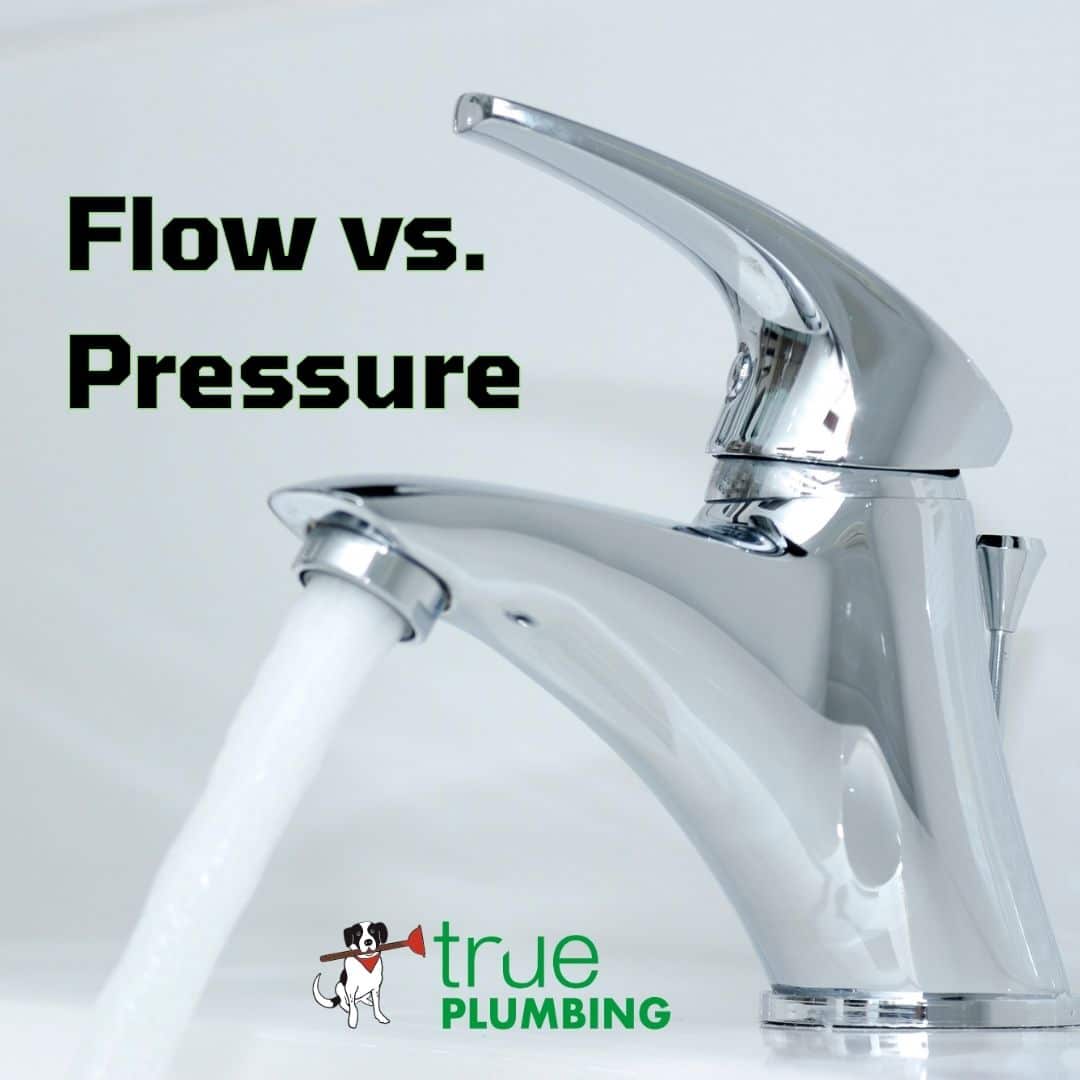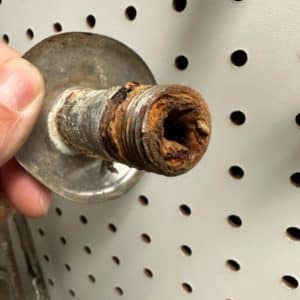
Flow is measured in gallons per minute (GPM). It’s the amount of water that’s coming out of a fixture. Flow determines how much water is actually coming out of your shower head when you shower.
Pressure is measured in pounds per square inch (PSI). It’s the force with which water is coming out of your fixture. Pressure determines how hard the water hits your hand when it comes out of the faucet.
(See the P.S. at the bottom for a more in-depth analogy using electricity as an example!)
The key concept is that you can have high pressure but see low flow from your faucet. And you can have low pressure while experiencing high flow. This is the key to starting a diagnosis in the world of plumbing.
Our first diagnosis step is to do a static pressure test and then a dynamic pressure test. Read more about these tests here.
Below are some common causes for low pressure or flow in the Atlanta area:
Galvanized water lines. If your home was built before 1980, your water service line and interior water lines could be galvanized steel. Over time the zinc coating that is applied to the interior of the steel pipe sheds away and then the iron begins to rust. Years will go by and rust will slowly build up, eventually clogging the pipe like an artery resulting in a restricted flow. Your water pressure may still read satisfactory or even high, but when you turn on more than one fixture, you may see a drop in flow. At the same time the walls of the pipes become thinner and eventually they will leak.
Rusted/restricted galvanized pipe
Valve partially closed. Sometimes a loss or drop in flow is due to a valve being partially or fully closed. This sounds too simple to warrant a visit from your plumber, but some valves can break, or are mislabeled. Once on a job in Sandy Springs, I had to dig up several water meter boxes out near the street to figure out which valve controlled a particular home. The handle for the valve was spinning freely—not stopping in either direction at any point—so it wasn’t clear whether it was on or off!
Debris in a supply line. Many valves have a rubber washer that creates a seal to stop the flow. Over time the chlorine in water deteriorates the rubber, resulting in it breaking up into bits and flowing downstream into the fixture. This creates a bottleneck where flow is restricted. Sometimes we can fish out the debris or replace the clogged parts, but if it is lodged deep inside we may have to replace the faucet.
Clogged aerator. Most fixtures have an aerator to regulate the flow and create a pleasant stream of water for use. It’s common for debris to get caught in the aerator, resulting in a need for cleaning or replacement. Shower heads are a bit tougher to unclog than a standard faucet aerator, so it’s usually better to replace them. Cleaning them with chemicals will break down the rubber components so we do not recommend this for a long term fix.
Pinched PEX or polybutylene line. Pipe materials can be rigid or flexible and when installed underground, they are subject to the settling, shifting and compacting of dirt. Sometimes these forces take many years to cause a problem. Once I found a 1970’s home in Brookhaven with a copper waterline that was kinked as it passed through the foundation. It probably took years for the flow to slowly decrease. On another service call I uncovered a PEX line feeding a 2015 Dunwoody home that was kinked due to a sidewalk settling over it.
Loss of pressure on the city water main. This is a temporary reason for your pressure, and therefore flow, to become lower. Sometimes we will receive calls from certain areas in Atlanta with customers saying their water is mysteriously off, but then it is back on within a few hours.
Clogged or dysfunctional Pressure Reducing Valve. The PRV is one of the most discussed devices in service plumbing because it is so important and has an effect on all fixtures in your home. We replace them often because they fail the static and dynamic pressure tests. When a PRV fails a dynamic pressure test, it is either not opening and closing properly, or it could have a buildup of debris inside.
Clogged water filter. Most water filters need to be replaced over time. In general the service intervals range from 6 months to 2 years. Some filters are self-flushing and do not need to be serviced for 10 years. But if large amounts of debris go through your line, the filter is just doing its job. We provide and install iSpring filters and you can see their whole service line here.
Worried you may have a flow or pressure issue in your home? Call or text 770-PLUMBER for same day service in the Atlanta metro area!
P.S. For you electricians out there, I love the analogy of:
Volts = PSI
Ohms = Pipe diameter
Amps = GPM or flow rate
Watts = Power of the combined PSI, Pipe diameter, and Flow rate
So, water moving through a garden hose is analogous to electrical current moving along a copper wire in the following ways:
- The force acting on the water (PSI) is like the Voltage pushing electrons through the copper wire.
- The diameter of the garden hose determines how much water can flow through it with ease. Ohms measure the resistance of an electrical conductor, such as copper. A thicker copper wire has lower resistance, allowing electrons to flow through it with ease, just as a large garden hose does not inhibit the flow of water passing through.
- The gallons per minute (GPM) or amount of water flowing through the hose is comparable to the rate of electrical current or amps.
- There isn’t a term for hydraulics that is 100% comparable to wattage, but to complete our electrical analogy, we can think of the final amount of power resulting from the factors of PSI, pipe size, and GPM. You must have all three for a nicely functioning system, and if you turn up any one factor, you may think your home has a nice pressure or flow, but unnecessary stress is put on the walls of your pipes.


